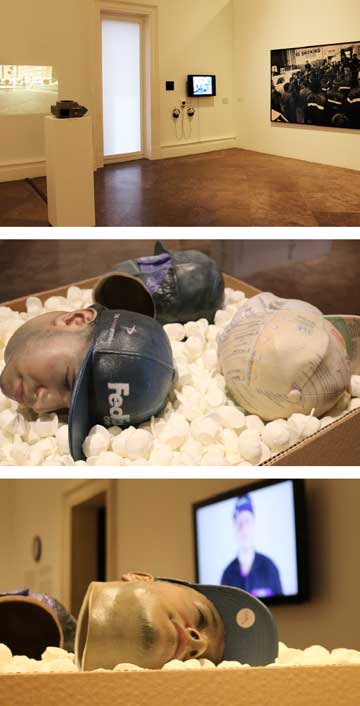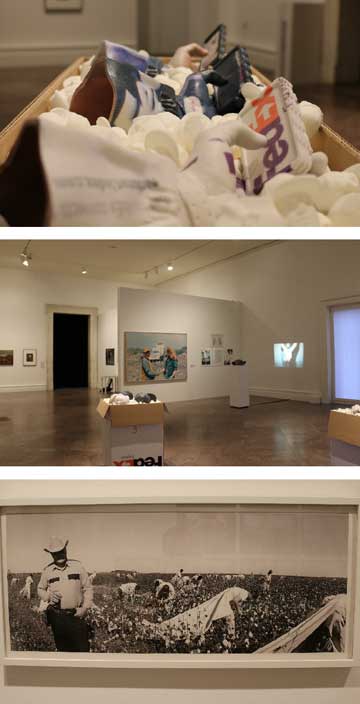Next story: Buffalo Brewing Company keeps moving toward its goal
Labor is celebrated in an exhibit at the AKAG
by Peter Soscia

A reoccurring theme of artwork is labor and the common worker. The hard working, blue-collar laborer has been an inspiration for artists for centuries. “Hard working and blue-collar” are also two of the more common themes associated with Buffalo workers, which makes Overtime: The Art of Work exhibition fitting for the Albright Knox Art Gallery.


Currently on display at the gallery until May 17, the exhibit looks at how and why artists continue to the represent work and workers, and how the pieces fundamentally changed with the rise of the industrial revolution in mid-nineteenth century. “This is the first exhibition on this theme here at the museum. A lot of the works may be familiar to people and have been included in other exhibits, but instead of the theme being about an historic time period or an artistic genre, in the context of this exhibition, I’m encouraging people to think about the work and the job that’s represented in the piece,” said Albright Knox Art Gallery Curator Cathleen Chaffee.
After working with the Yale University Art Gallery, New York’s Museum of Modern Art, and the Cleveland Museum of Art, Chaffee was hired as Curator at the Knox Gallery in January, 2014. The Overtime exhibit was one of the first things she wanted to bring to the gallery. “The idea for the exhibition was something I had been thinking about for a while, and I proposed the idea about a month after I got here,” said Chaffee. “Work is a subject that continues to fascinate artists, and I’ve always been interested in things like this. Things that seem so everyday, we all punch the clock in one way or another. It’s something that’s so universal and common, but people often think about art as being this realm of the uncommon, but really the subject of the worker stays a familiar theme for artists throughout history.”
The exhibition features approximately 50 pieces; half are from the gallery’s permanent collection, the other half are on loan from artists and other galleries. Instead of the exhibit being an extensive survey of the entire theme of labor in art, Chaffee wanted the exhibit to have a specific focus.
“The exhibit is a focus look. One of things that I was really interested in as I started putting the show together was realizing how much we had on the topic here in the collection. I started thinking about how we organize things and the space couldn’t possibly hold a survey. I realized that the works that I was drawn to and the works here in the collection represented the very different reasons why artists keep returning to the subject of the worker. Sometimes it’s to heroize them, sometimes it’s to represent their plight, and sometimes it’s to point towards the unrepresented aspects of culture, so that really became the focus for this; Why do artists keep returning to this subject?” said Chaffee.
While the earliest painting in the collection is the 1774 piece by Joshua Reynolds Cupid as Link Boy, the rest of the pieces encompass labor in the industrial era, starting with the locally famous painting of the Buffalo Newsboy by Thomas Le Clear (1853) and Honore Daumier’s Laundress on the Quai d’Anjou (ca. 1860.) The exhibit expands throughout the roughly 160-year history of the modern day laborer.
The artwork is shown in a wide range of mediums from traditional paintings, drawing, and photography, to the use of new media with five video installations and an installation created by a 3D printer. “I didn’t approach the show thinking about medium, I was thinking about the continuity of the reasons why artists are so often looking at work as a subject, from modernity to contemporary life,” said Chaffee.
“We have a piece from Josh Kline that uses a 3D-printer, that’s as contemporary of a medium as you can get, but the themes he’s drawing out completely relate to the paintings from the nineteenth century, they’re both taking a look at something that is not commonly heroized or represented.”
Along with the Buffalo Newsboy, the exhibit features many pieces by local artists, including nationally acclaimed photojournalist Bruce Jackson with his work from an Arkansas prison farm in the 1970s, as well as photography by Milton Rogovin. Originally an optometrist in the 1930s, Rogovin’s leftist views labeled him a communist during the red scare following WWII. Forced to give up his practice, Rogovin took on photography, capturing the expressions of workers from the steel mills in Buffalo to the day laborers of the Yucatan.
A large section of the exhibition is dedicated to the photographs, videos, and slides, from Mierle Laderman Ukeles’ Touch Sanitation. The work documents Ukeles’ project to shake the hand of every (8,500) New York City sanitation workers. “This is a project that Ukeles did in the 1970s. As a young married woman she started realizing that much of the work of a woman involved maintaining the home and really keeping the home together. So as an artist and a human really, she started identifying with other people working in these forms of maintenance. She started thinking about all the jobs that are keeping society together,” said Chaffee.
Ukeles would become the first and only Artist In Residence for the New York City Department of Sanitation, and thus started her Touch Sanitation project. “When [Ukeles] shook the hand of the sanitation workers she would say: ‘Thank you for what you do to keep this city alive,’ in the sense that there are people who work in ways that are actually necessary to the survival of modern life. That’s sort of the idea behind a lot of the Overtime exhibition as well,” said Chaffee.
Mierle Laderman Ukeles will be in house at the Albright Knox Art Gallery speaking about her work with the Touch Sanitation project and the NYC Department of Sanitation on Thursday, April 30, at 6pm. the talk is free to the public.
blog comments powered by Disqus
|
Issue Navigation> Issue Index > v14n16 (Week of Thursday, April 23) > Labor is celebrated in an exhibit at the AKAG This Week's Issue • Artvoice Daily • Artvoice TV • Events Calendar • Classifieds |









 Current Issue
Current Issue